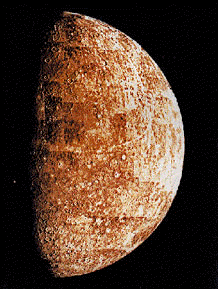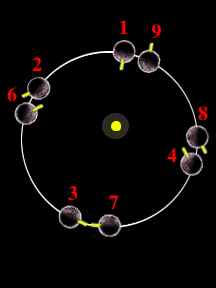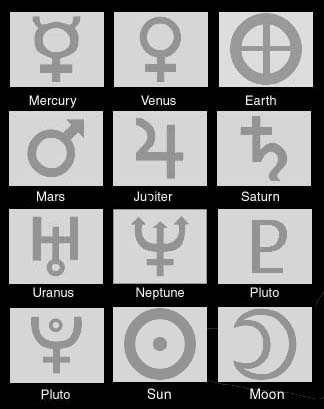Quickie Questions - Other Solar System Stuff - Mercury
| Date Answered | Questioner (age, location) | Question | Answer |
|---|---|---|---|
| October 2, 2009 | callum (age 14, australia) | what is the most commen element found on mercury? | Mercury consists of approximately 70% metallic and 30% silicate material. Mercury's core,which occupies occupies about 42% of its volume, has a higher iron content than that of any other major planet in the Solar System. |
| August 11, 2009 | Kodi (age 13, Minnesota) | what is the distance in light minutes/hours between earth and mercury? | Mercury's minimum distance from Earth is 77.3 million km or 0.0716236238 light hours. |
| August 6, 2009 | Catherine (age 11, Vancouver,WA) | When do we get to see Mercury? If so,When? | Because of Mercury's size and closeness to the sun, the planet is often hard to see without a telescope. From the northern hemisphere, it is visible in the morning sky this year in February and early March, June, and October. In the evening, Mercury is best seen in April and early May, August and early September, and December. Adapted from StarDate online. |
| May 19, 2009 | julie (age , ) | Yes, and the same will happen to Venus and Earth in about 5 billion years (5000 000 000 years), when the hydrogen in the center of the Sun will start to run out, the helium will get squeezed, and this will speed up the hydrogen burning. Our star will slowly puff into a red giant and will eventually eat all of the inner planets, including the Earth. | |
| May 18, 2009 | Hannah (age 11, QLD) | What is Mercury's surface made of? I really need to know for a school project! | Mercury, the innermost planet of the solar system, is a little bigger than the Earth's Moon. The surface of the planet is covered with craters, like the Moon, but temperatures there can reach over 800oF because Mercury is so close to the Sun and rotates so slowly. The composition of Mercury is probably high in iron, although surface features indicate that volcanic activity once existed at the surface. |
| April 16, 2009 | Paige (age 13, AL/US) | We have a report to do and i was wondering what EXACTLY is Mercury's atmosphere like? at least 2 paragraphs, please? | So far, observations of Mercury from ground-based observers and the Mariner 10 spacecraft have not shown evidence of a significant atmosphere compared to other planets. Mariner 10 did observe a tiny amount of helium 1000 km above the surface, but this is probably caused by the solar wind and the breakdown of Mercury's crust. Sodium, potassium and oxygen have also been detected in Mercury's very weak atmosphere, but these elements can be lost when they react with the Sun and Mercury's magnetic field. |
| March 16, 2009 | shannon (age 12, san antonio ,tx) | how long is a day on the planet of mercury | The lenght of Mercury day (Rotation Period about Axis) is 58.65 Earth days. |
| March 4, 2009 | jodi (age 11, canada) | what kind of weather appears on Mercury | Weather occurs in the atmosphere and, so far, observations of Mercury from ground-based observers and the Mariner 10 spacecraft have not shown evidence of a significant atmosphere compared to other planets. |
| January 30, 2009 | hanna (age 10, minnesota) | whatis the atmespheric composition of mercury | So far, observations of Mercury from ground-based observers and the Mariner 10 spacecraft have not shown evidence of a significant atmosphere compared to other planets. Mariner 10 did observe a tiny amount of helium 1000 km above the surface, but this is probably caused by the solar wind and the breakdown of Mercury's crust. Sodium, potassium and oxygen have also been detected in Mercury's very weak atmosphere, but these elements can be lost when they react with the Sun and Mercury's magnetic field. |
| September 25, 2008 | Catie (age 13, Australia) | What is the average tempurature of Mercury?? | Mercury average surface temperature is 440 K (166.8 ºC or 332.3 ºF) |
| August 25, 2008 | saniya (age 12, hyderabad,INDIA) | what new information in mercury in the year 2008? | This page about MESSENGER's First Mercury Flyby Reveals a "Whole New Planet". |
| August 18, 2008 | Mariana (age 12, Melbourne-Australia) | Who discovered Mercury and when? | Mercury's orbit is so close to the Sun that it is difficult to see from Earth. This explains why some early astronomers never saw the planet. Viewed from Earth, Mercury is never far from the Sun in the sky. Because of the glare of the Sun, it can only be seen in twilight. Timocharis made the first recorded observation of Mercury in 265 BC. Other early astronomers that studied Mercury include Zupus (1639), who studied the planet's orbit. More information on our web page Mercury. |
| August 15, 2008 | Michael (age 10, California, Irvine) | Why is mercury not the hottest planet? | It is because Venus has a dense atmosphere that creates a strong green house effect. Temperature in Venus can reach more than 450oC (approaching 900F - high enough to melt lead). |
| August 14, 2008 | Cassidy (age 13, Ca, USA) | Does Mercury revolve on it's own axis? | Mercury's rotation period about its axis corresponds to 58.65 Earth's days. |
| July 8, 2008 | shawn (age 13, missouri) | who named mercury | Mercury was named by the Romans after the messenger of the gods because it seemed to move more quickly than any other planet. Timocharis made the first recorded observation of Mercury in 265 BC. Other early astronomers that studied Mercury include Zupus (1639), who studied the planet's orbit. Because it is so difficult to make out features on the surface of the planet from Earth, it was not until the 1960s that scientists determined the correct day length rate (59 Earth days) of the planet on its axis. This also showed that Mercury's day length and year length are the same. |
| May 12, 2008 | Micaela (age 12, U.S.A, Utah) | Is Mercury a solid or gas? | Mercury is a rocky planet. Scientists believe that the interior structure of Mercury includes a metallic core, an intermediate rocky layer, and a thin brittle crust. |
| April 25, 2008 | dontae (age 11, nd usa) | what adaptations are needed to live on mercury | There are many adaptations needed for the humans to live in Mercury, but a critical factor are the extreme temperatures in this planet, between -184oC to 427oC (-300oF to 800oF). |
| April 18, 2008 | veronicia (age 10, ) | What is Mercury's revuloution??? | Mercury's Rotation Period about Axis is 58.65 days. |
| April 7, 2008 | KIRWY (age 8, bc) | HOW MUCH WILL I WEIGH ON MERCURY | Surface gravity in Mercury is 3.7 m/s2 (0.38 x Earth's). If you weight 100 lb on earth, you will weight 38 lb on Mercury. |
| April 7, 2008 | KIRWY (age 8, bc) | IS THERE LIFE ON MERCURY | Scientists have not found any sign of extraterrestrial life, but they keep looking! |
| April 1, 2008 | janelle (age 12, Indiana) | what is the color of murcury? | The rocky surface of Mercury is of a dark gray color. |
| March 12, 2008 | chad (age , ) | Because Mercury is so close to the Sun, it is difficult to see Mercury from Earth. The best time to see it is near sunrise or sunset, when it is out of the light. Mercury is not visible at night because when the Sun sets, so does Mercury. A special opportunity to see Mercury happens on rare occasions, when it passes directly between the Sun and the Earth. | |
| February 4, 2008 | Adalise (age 13, Mississippi) | What is Mercury's orbit speed in km? | Mer ury's mean orbital speed is 47.89 km/s (29.8 miles/s). |
| February 3, 2008 | Jackie (age 12, Alabama) | What is the length of a sidereal day in mercury?? | Mercury's rotation period about its axis corresponds to 58.65 Earth's days. |
| February 3, 2008 | Jackie (age 12, Alabama) | What is mercury's mass? | Mercury's mass is 0.33x1024 kilograms (0.06 x Earth's) |
| January 21, 2008 | Austin (age 11, Ontario, Canada) | Will Mercury ever get its own moon? | Because its proximity to the Sun, it is very unlikely that Mercury will have its own moon. |
| January 1, 2008 | anoosh (age 10, canada) | what is the diameter of mercury?please and thank you. | The diameter of Mercury is 4 878 km (3,030 miles). |
| December 21, 2007 | Alexa (age 9, ) | What is the length of time it takes Mercury to complete it's orbit around the sun? | For Mercury: Rotation Period about Axis: 58.65 Earth days Revolution Period about the Sun: 0.24 Earth years |
| December 20, 2007 | Kat (age 10, The U.S.A.) | What is Mercury's orbital period? | For Mercury: Rotation Period about Axis: 58.65 Earth days Revolution Period about the Sun: 0.24 Earth years |
| October 18, 2007 | nosipho (age 16, SA) | what the revolution of mercury | Rotation Period about Axis (Mercury day): 58.65 days Revolution Period about the Sun (Mercury year): 0.24 years |
| September 18, 2007 | Stephanie (age 14, Australia) | What Gases Are Mercury Made up of? | Mercury is a rocky (solid) planet. So far, observations of Mercury from ground-based observers and the Mariner 10 spacecraft have not shown evidence of a significant atmosphere compared to other planets. Mariner 10 did observe a tiny amount of helium 1000 km above the surface, but this is probably caused by the solar wind and the breakdown of Mercury's crust. Sodium, potassium and oxygen have also been detected in Mercury's very weak atmosphere, but these elements can be lost when they react with the Sun and Mercury's magnetic field. More information in our web page Atmosphere of Mercury. |
| September 11, 2007 | Jack (age 12, South Australia) | Hello. How long is 1 Mercury Year? | A year in Mercury (its revolution period about the Sun) is 0.24 Earth's year or about 88 Earth days. |
| July 19, 2007 | lucy (age 11, australia) | can you tell me some information about mercury | Mercury, the innermost planet of the solar system, is a little bigger than the Earth's Moon. The surface of the planet is covered with craters, like the Moon, but temperatures there can reach over 800oF because Mercury is so close to the Sun and rotates so slowly. More information in our web page Mercury. Some interesting facts in our web page . |
| July 5, 2007 | Kiara (age 10, MI) | What is the distance from Sun to Mercury? | Mercury's minimum distance from Sun is 46.0 million km (28.6 million miles) and its maximum distance from Sun is 69.8 million km (43.4 million miles). |
| July 2, 2007 | Marissa (age 12, North Carolina) | Does Mercury have volcanoes? | There is a number of volcanoes on Mercury's surface, which helped to make the surface the shape it is now, but there is no evidence of any active volcanoes on Mercury today. |
| May 23, 2007 | Kristina (age 11, Canada) | Why does Mercury have no moons.Please expain. | Mercury and Venus are the only planets that do not have either rings or moons. The more likely reason is that these planets are very close to the Sun, and its strong gravity would interfere with anything in orbit around those two planets. |
| May 22, 2007 | LaToya Martin (age 24, Ms) | what is mercury atmosphere | So far, observations of Mercury from ground-based observers and the Mariner 10 spacecraft have not shown evidence of a significant atmosphere compared to other planets. Mariner 10 did observe a tiny amount of helium 1000 km above the surface, but this is probably caused by the solar wind and the breakdown of Mercury's crust. Sodium, potassium and oxygen have also been detected in Mercury's very weak atmosphere, but these elements can be lost when they react with the Sun and Mercury's magnetic field. |
| May 10, 2007 | Amanda (age 10, South Carolina, North America) | Could we oneday live on Mercury? why or why not? | The temperature range on Mercury goes form -184oC to 427oC (-300oF to 800oF). So, sustained human life there would be very difficult. |
| May 5, 2007 | Joe (age 14, CA) | Where is mercury located in the solar system? | Mercury, at about 58 million km from the Sun, is the closest planet to our star. |
| May 1, 2007 | Gabriela (age 10, newyork) | When was Mercury discovered? | Mercury has been observed for thousands of years. There is no record about the first person to observe it. In Roman mythology, Mercury was the messenger-god of Jupiter, and was the god of games, of business, and of story telling. He was the offspring of the god Jupiter and Maia. |
| April 19, 2007 | Isaiah (age 12, Az) | HOW LONG WILL A HUMAN LIVE ON MERCRUY? | Mercury, with a range of temperature between -184oC and 427oC (-300oF to 800oF) is very unfriendly for humans! |
| April 19, 2007 | Isaiah (age 12, Az) | HOW LONG WILL A HUMAN LIVE ON MERCRUY? | Mercury, with a range of temperature between -184oC to 427oC (-300oF to 800oF) is very unfriendly for humans! |
| February 22, 2007 | Frog (age 13, Florida) | Is there an axis tilt on mercury, if so what is it? | The tilt of Mercury's axis is 0 degree. For more interesting facts about this planet visit our web page mercury Statistics. |
| February 20, 2007 | Kody (age 12, Missouri) | Does Mercury Have storms?Why or Why not? | The lack of an atmosphere in Mercury excludes the possibility of storms. |
| January 22, 2007 | mandy (age 12, U.S.A) | how big is mercury? help | Mercury has a diameter of 4 878 km (3,030 miles), a mass of 0.33x10^24 kilograms (0.06 x Earth's), and a density of 5,427 kg/m^3. For more interesting facts, visite our web page Mercury Statistics. |
| January 21, 2007 | Ramsey (age 9, Georgia) | How would you describe Mercury??? | Mercury, the innermost planet of the solar system, is a little bigger than the Earth's Moon. The surface of the planet is covered with craters, like the Moon, but temperatures there can reach over 800oF because Mercury is so close to the Sun and rotates so slowly. Scientists believe that the interior structure of Mercury includes a metallic core, an intermediate rocky layer, and a thin brittle crust. The composition of Mercury is probably high in iron, although surface features indicate that volcanic activity once existed at the surface. There is little evidence of motions near the surface of the planet now, although at earlier times during Mercury's evolution the surface was much more active. We know relatively little about Mercury, compared to most of the other planets, because it is relatively difficult to see and only one spacecraft has studied the planet. For more information, please visite our web page Mercury. |
| January 21, 2007 | Ramsey (age 9, Georgia) | How would you describe Mercury??? | Mercury, the innermost planet of the solar system, is a little bigger than the Earth's Moon. The surface of the planet is covered with craters, like the Moon, but temperatures there can reach over 800oF because Mercury is so close to the Sun and rotates so slowly. Scientists believe that the interior structure of Mercury includes a metallic core, an intermediate rocky layer, and a thin brittle crust. The composition of Mercury is probably high in iron, although surface features indicate that volcanic activity once existed at the surface. There is little evidence of motions near the surface of the planet now, although at earlier times during Mercury's evolution the surface was much more active. We know relatively little about Mercury, compared to most of the other planets, because it is relatively difficult to see and only one spacecraft has studied the planet. For more information, please visite our web page Mercury. |
| January 16, 2007 | matthew (age 12, alberta) | whats the surface appearance like on mercury. | The surface of Mercury is covered with craters, like the Moon, but temperatures there can reach over 800 F because its proximity to the Sun and slow rotation. More information about this planet can be found in our web page Mercury. |
| January 3, 2007 | kelley (age 12, Colorado) | describe mercury's weather conditions | The main characteristic of Mercury is its huge temperature range, which goes from -184 C to 427 C (-300 F to 800 F). |
| January 3, 2007 | trent (age 10, cal) | what would you need to survive on Mercury | Keeping in mind the temperature range on Mercury: -184 C to 427 C (-300 F to 800 F), the protection against these extreme changes in temperature would be the first thing that comes to mind. |
| December 20, 2006 | saim (age 12, Canada) | what is the meaning of mercury's name? | Mercury was the messenger-god of Jupiter, and was the god of games, of business, and of story telling. He was the offspring of the god Jupiter and Maia. Maia herself was and one of the Pleiades, daughters of the titan Atlas. Mercury was identified with the Greek god Hermes. |
| December 13, 2006 | keila (age 11, il.usa) | how long is an hour on mercury | The rotation period of mercury about its axis (day) is 58.65 Earth days. |
| December 11, 2006 | Austin (age 11, Colorado) | what are some fun facts about mercury? | Some of the main planetary facts for Mercury are: Diameter: 4 878 km (3 030 miles); Rotation Period about Axis: 58.65 days; Mass: 0.33x10^24 kilograms (0.06 x Earth's); Revolution Period about the Sun: 0.24 years; Density: 5,427 kg/m^3; Maximum Distance from Sun: 69.8 million km (43.4 million miles); Minimum Distance from Sun: 46.0 million km (28.6 million miles); Surface Gravity: 3.7 m/s^2 (0.38 x Earth's); Temperature Range: -184 oC to 427 oC (-300 oF to 800 oF). More interesting facts on this page. |
| December 11, 2006 | stephanie (age 14, america) | are there any moons on mercury | No, there are no moons orbiting Mercury. |
| December 11, 2006 | Maksat (age 11, California) | Are there any evidence of volcanic activity on Mercury? | Scientists believe that the interior structure of Mercury includes a metallic core, an intermediate rocky layer, and a thin brittle crust. Surface features indicate that volcanic activity once existed at the surface. For more information, please visit our web page Mercury's Interior and Surface |
| December 6, 2006 | Aimee (age 15, Connecticut) | How far is Mercury from Earth? | Because all planets are constantly rotating around the Sun, it is useful to establish a frame to determine the average distance between two of them. Let’s assume for this calculation that Mercury and Earth are aligned with the Sun, and use their average distance to the Sun to determine the average distance between them: Mercury average distance to the Sun: 57.9 million km (36.0 million miles) Earth average distance to the Sun: 149.0 million km (92.8 million miles) Difference (average distance between the two planets): 91.1 million km (56.8 million miles) |
| June 3, 2002 | Christy (age 14, Vermont, USA) | I printed a picture of the planet Mercury and it had a big line on it. What is the line? | Without seeing the picture, I can't tell for sure. But, sometimes, pictures of planetary bodies have dark black lines or black dots on them. These are places where there wasn't data available. In other words, a picture of that part of the body wasn't taken or wasn't available. |
| September 14, 2001 | Rei (age 20, Florida, USA) | I heard from someone that Mercury is collapsing on itself. If this were to occur, how would the rest of the solar system be affected, if at all? | Mercury is pretty stable, and is not collapsing on itself. There is not enough material in planets to compress themselves in this way, so they stay pretty well constant in size. This sort of phenomenon does happen with stars when gravity begins to overcome the internal pressure created by fusion reactions at the center of the star. This in turn only happens when the star has used up all of its nuclear fuel and begins to burn out. You might be interested in our Tour of the life cycle of a star. |
| May 9, 2001 | Stephanie (13, Pennsylvania, USA) | How many natural satellites does Mercury have? | Mercury actually doesn't have any moons or rings! |
| March 19, 2001 | Hayley (age 13, Australia) | Has there been any attempts of exploration of Mercury? | Mariner 10 went there in the 70's! |
| June 22, 1999 | Matthew (age 26, Washington) | Will there be any more missions to explore the planets closest to the sun (Mercury & Venus)? | NASA has a number of current and future proposed missions to a large number of places. MESSENGER and VESPER are two possible missions to Mercury and Venus. I am currently working on a proposal for a landed mission to Mercury for submission to NASA's JPL at the end of the summer. |
| June 3, 1999 | Chris (age 15, New Jersey, USA) | When is Mercury visible? | This page will tell you what appears in this week's sky.... |
| May 26, 1999 | Carla (age 13, New York, USA) | Can any life, even single celled, live on Mercury? | Probably not. The temperatures on Mercury can reach 800 degrees F, hot enough to melt lead! Any living cell would be fried to a crisp rather quickly. Water hasn't been found on the planet, something that is necessary to sustain life. If we ever develop the technology to protect ourselves and provide the essentials for life, maybe one day we can live on Mercury. |
| January 8, 1999 | Jessica (age 13) | Does Mercury have seasons? | No. Seasons are cause by the tilt of the axis relative to the planet's orbital motion. Mercury's axis is directly perpendicular to its motion, so it has no seasons. |
| November 12, 1998 | Deanna (age 9, Illinois, USA) | Does Mercury have an atmosphere? | No, the most recent observations have shown Mercury to have almost no atmosphere. |
| May 27, 1998 | Candace (age 15, Virginia, USA) | Who discovered the planet Mercury and how did it get its name? | Mercury has been known since at least the time of the Sumerians (3rd millennium BC). Mercury is the god of commerce and transportation in Roman mythology. Mercury is the Roman counterpart to the Greek god Hermes, the messenger of the gods. Mercury probably got this particular name because it moves across the sky so quickly. |
| May 26, 1998 | Tim (age 34, England) | We noticed that Mercury's year is 88 Earth days and its day is 176 Earth days. Ok, so why is the day longer than the year ? | This link should explain Mercury's orbital resonance. |
| May 26, 1998 | Jay (age 12, Oklahoma, USA) | Why is there not alot information on Mercury? | Well, we do have some info on our site. But, you're right! There is not a ton of info out there. This is because there has only been one mission sent to Mercury. Mariner 10 flew by the planet in 1974 and mapped about half of the planet's surface. |
| April 17, 1998 | Beth (age 15, Florida, U.S.A.) | A day on Mercury is 176 Earth days, and a year on Mercury is 88 Earth days. How is a that??? | The reason is simply that Mercury sloooowwwwlllyyyy turns. Over the time Mercury has been around the Sun, it has evolved into this rhythm with the Sun. Another example sort-of like this is Pluto orbits the Sun EXACTLY 2 times for every 3 times Neptune does. They have reached a 'harmony' of orbits. What happens in bad harmonies? Prometheus, a Saturn moon in between 2 rings, found out the hard way. It is now in a different orbit than it was a few years ago. Prometheus got too close to the ring material and the collision moved the moon to an orbit 19 degrees off its orbit from before. |
| February 27, 1998 | Nathan (age 14, USA) | What is Mercury's closest and farthest orbital to the sun? And how much a 100lbs person would weight on Mercury | When Mercury is closest to the Sun, it is 46,000,000 km away. At its farthest, it is 69,800,000 km away. If you weighed 100 lbs (45 kg) on Earth, you would weigh 38 lbs (17 kg) on Mercury. |
| February 20, 1998 | Camille and Ken (Massachusetts, USA) | Is there a planet which goes through phases like the moon, is seen just before sunrise, and just after sunset for about fifteen minutes, and has been seen to go westward on some nights, and eastward on other nights? What planet would you say it would be, or does such a planet not exist in this solar system? | The planet is probably Mercury. Mercury and Venus both show phases, but Venus can be seen for much longer than just 15 minutes. |
| January 6, 1998 | Jojo (age 9, Washington, D.C., USA) | Is Mercury really grey, or does it just look that way because of the photographs? | It is really grey! In fact, it looks a lot like our Moon does, including all of those craters! |
| January 6, 1998 | Cassie (age 13, Nevada, USA) | What is Mercury's composition? | Scientists think that Mercury is almost 70% iron. Most of this iron is probably concentrated in the planet's core. So even though Mercury is one of the smallest planets, it is the second most dense planet in the solar system. |
| December 30, 1997 | Christie (age 13, Corvallis, USA) | How hot is Pluto? Mars? Mercury? | Pluto:-229o C Mars:-82o C to 0o C Mercury:-184o C to 427o C This information is available for every planet on each planet's Planetary Facts page. |
| November 26, 1997 | Cassie (age 13, Nevada, USA) | When was Mercury discovered? | Mercury has been known since at least the time of the Sumerians in the 3rd millennium B.C. |













